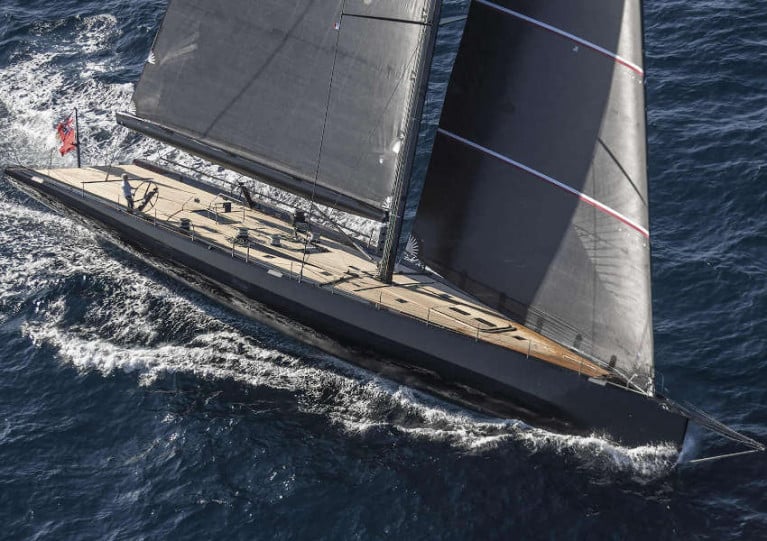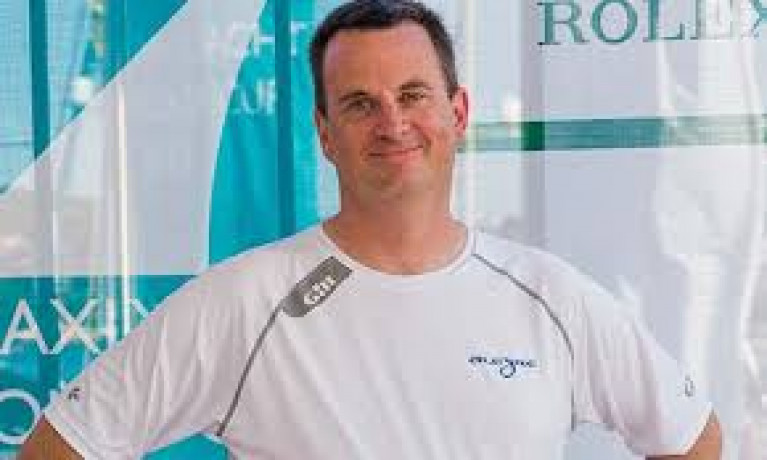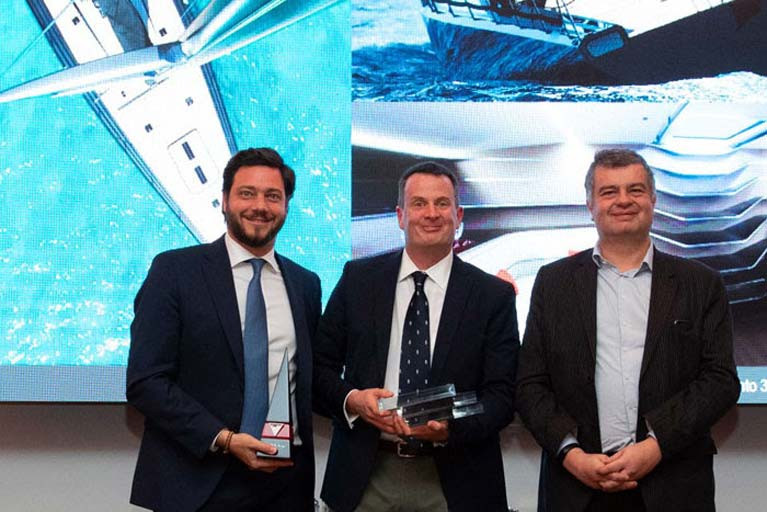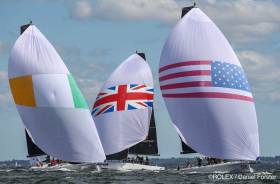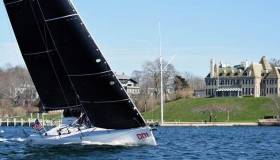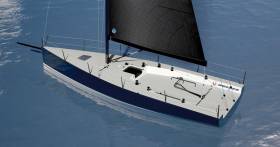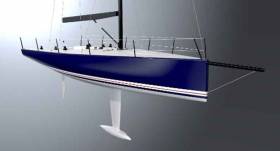Displaying items by tag: Mark Mills
Wicklow Superyacht Designer Mark Mills Wins Another International Award
County Wicklow-based international superyacht designer Mark Mills has scooped another major trophy at the stratospheric end of the global sailboat design spectrum. Back in April, he was an Afloat.ie "Sailor of the Month" awardee when his very advanced prototype Wally 100 Tango took the MDO Monte Carlo Prize. And now he is supreme in another category, as announced at the even more exotic Mediterranean location of Capri.
 Mark Mills: Internationally awarded in Monaco in April, and Capri in September…..yet his heart is in the midst of County Wicklow
Mark Mills: Internationally awarded in Monaco in April, and Capri in September…..yet his heart is in the midst of County Wicklow
His MD75 Karma, built by Maxi Dolphin, has been voted the Best Sailing Yacht at The International Yacht & Aviation Awards 2020. A striking high-performance design for an Italian client, she combines a sleek minimalist exterior with a relaxed and engaging interior by Nauta Design in Milan, the complete package making us realise that the notion of "less is more" acquires a different sense of meaning with a 75-foot performance cruiser.
Last Friday 4th September, international media group design et al hosted the final process of The 10th Anniversary International Yacht & Aviation Awards 2020 in Capri, and the winners of the 2020 Awards were announced after an exhaustive selection process only made possible by some very advanced technology. The unique voting system enabled 12,441 global industry professionals to individually acknowledge, consider and finally vote for the shortlisted nominees.
 Utterly minimalist – Karma's appearance is decidedly different from that of the Irish traditional trading ketch Ilen which is also currently featuring on Afloat.ie
Utterly minimalist – Karma's appearance is decidedly different from that of the Irish traditional trading ketch Ilen which is also currently featuring on Afloat.ie
Although design et al is an internationally-recognised powerhouse in top-level creativity, its ultimate headquarters is in Chester in northwest England, just across the channel from Mark Mills' design studio in the heart of County Wicklow. Nevertheless, the very international voting system means that we can be reasonably sure it wasn't an Irish Sea Offshore Racing Association stitch-up when Karma was announced as the winner in the Best Sailing Yacht category.
Certainly, Mark Mills is thrilled with this second major first prize in 2020 for Mills Design: "We love working on projects like this, where a combination of sleek looks, true performance aspirations, and great collaborators ensure the result will be outstanding. It's an honour to be recognised by the industry with such a prestigious award."
 Karma's saloon is intended for relaxation after day sailing, and is definitely not designed for rugged overnight passages
Karma's saloon is intended for relaxation after day sailing, and is definitely not designed for rugged overnight passages
Inevitably it is Mark Mills' work at the glossy peaks of the international marine industry that attracts the most attention and the prestigious prizes, but he continues to be an avid enthusiast for the challenge of designing front-line offshore racers. Thus as the more everyday sailing world struggles back to post-pandemic normality, we can expect the Mills-designed Melges IC37 – with which Anthony O'Leary and his Royal Cork crew took the Bronze at last September's New York YC Invitational at Newport, RI – to make the impact she merits on the European scene.
 Prototype Mark Mills-designed Melges IC37 testing North Sails off the New York YC's Harbour Court at Newport, Rhode Island. After the semi-hiatus of the non-season of 2020, it is expected that that the IC37 will be making an impact in Europe in 2021
Prototype Mark Mills-designed Melges IC37 testing North Sails off the New York YC's Harbour Court at Newport, Rhode Island. After the semi-hiatus of the non-season of 2020, it is expected that that the IC37 will be making an impact in Europe in 2021
Yacht designer Mark Mills is the latest speaker in the Royal Irish Yacht Club’s special series of online talks tonight, Wednesday 10 June.
Mark Mills started Mills Design in 1995 with an order from Peter Beamish for the 31ft Aztec, built in Malahide by Mizzen Marine.
Building on her success, his custom designs have won numerous titles including the 100ft Wallycento Tango, the Maxi72 World Champion Alegre 3, multiple IRC Championship winners Mariners Cove and Tiamat, and the 69ft IMA Mini-Maxi Champion Alegre.
Equally his production designs such as the IC 37 for the NYYC, double ORC World Champion Landmark 43, C&C30, Cape 31, King 40 and DK 46 are well known worldwide.
Originally from California, Mills studied yacht design at the Southampton Institute while racing with some of the best teams in the UK.
He won with the Seahorse Sailor of the Month in December 2014, the 2009 Irish Sailor of the Year award, was named the Asian Marine & Boating Best Designer of 2010 and 2015, and recognised closer to home with Wicklow Sailing Club’s Irish Holly trophy.
Most recently, he won first prize at the premiere edition of the MDO Montecarlo prize for the Wallycento Tango.
A member of the RORC Technical Committee and an advisor to both the US and Irish IRC owners groups, Mills has spoken around the world on yacht design and rating rules for events such as IBEX both in the US and Europe, the International Yacht Forum, and regularly at ICRA meetings.
He was one of the initial HPR Committee members who helped draft the High Performance Rule for the NYYC, and subsequently joined the Sailing Yacht Research Foundation (SYRF) Advisory Board.
This evening, he follows the likes of Julian Everitt in the RIYC’s special series of talks with some of the world most renowned yacht designers. RIYC members should contact [email protected] to attend this talk, which starts at 7.30pm this evening, Wednesday 10 June, via the Zoom platform.
In a time of inevitable national introspection, the design work of Mark Mills is a breath of global fresh sea air, taking us out of ourselves. Already in 2020, his design work has been recognised with the MDO Montecarlo Trophy for the quality of the biggest vessel to emerge from his County Wicklow design studio to date, the 30-metre Wallycento Tango. And his smaller designs continue to attract, with the rapidly-growing popularity of his Melges IC37 - in which Anthony O’Leary’s Royal Cork team took the Bronze at last Autumn New York YC Invitational - a testament to the versatility of this talented naval architect, our International Sailor of the Month for April.
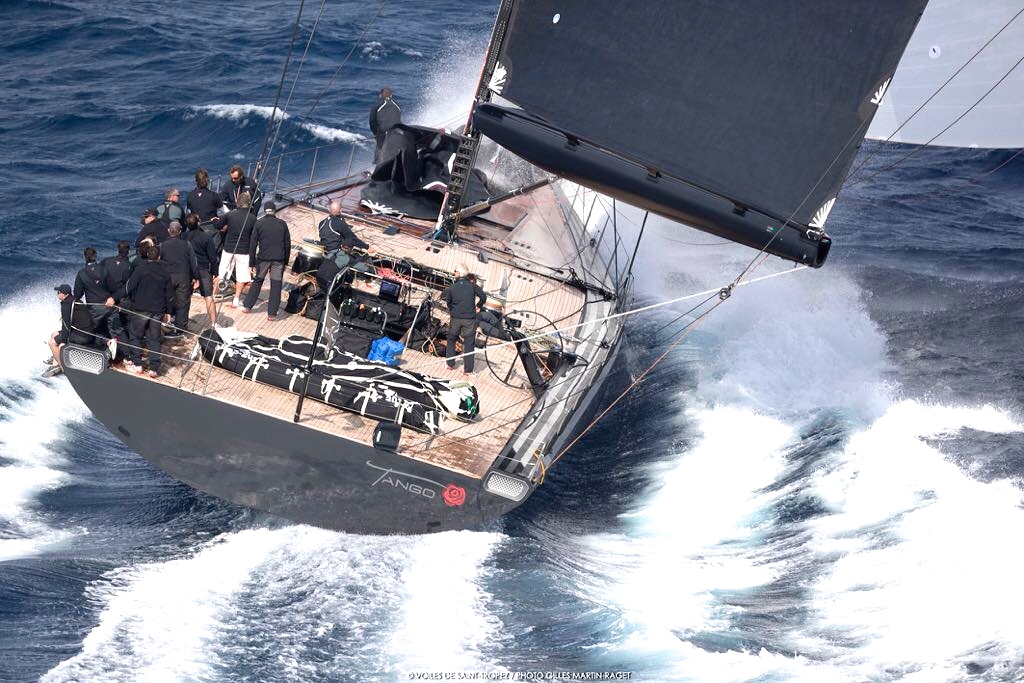 The big one – the Mark Mills-designed Tango
The big one – the Mark Mills-designed Tango
Wicklow Yacht Designer Mark Mills Wins International Award
County Wicklow based yacht designer Mark Mills and Wally Yachts have won first prize at the première edition of the MDO Montecarlo prize for the wallycento Tango.
Wally and Mills were honoured at the awards ceremony held at the Yacht Club de Monaco with first place in the competition, which celebrates international excellence in innovation, technology, design and sustainability.
The prizes were accepted by Mark Mills of Mills Design, and Stefano de Vivo, managing director of Wally, representing a design group including Pininfarina, Persico Marine, and Pure Engineering. Once again, an international award recognises our work in yacht design and innovation, this time on the wider basis of architectural and product design on a global scale.
The nominees were judged by a panel of prominent authorities on design – including renowned architects Mario Botta, Richard England and Jean-Michel Wilmotte- based on their stylistic, dimensional, functional and economic traits and features.
Wicklow Designed IC37 is 'Perfect Fleet Racing Boat'
Ireland is on the International yacht racing stage this week thanks to triumphs on the water and off at last Saturday's Rolex New York Yacht Club Invitational Cup.
As Afloat reported previously, the Crosshaven, County Cork team led by Anthony O'Leary snatched the bronze medal from Canada in a superlative last day finish while the Kilbride, County Wicklow design team of Mark Mills is celebrating the success of its new IC37s used at the prestigious Big Apple event.
The Invitational Cup produced stunning racing across the full range of conditions for the Club’s fleet of 20 new Mills designed Melges IC37’s. This sixth edition of the biennial Corinthian championship was a true test of talent, teamwork and perseverance over four days and twelve races. After a strong early showing by the San Diego Yacht Club, the Royal Sydney Yacht Squadron came to the fore to win the event on the final day. Six-time participant Royal Cork Yacht Club won the last race to take the final podium placing.
The response to the new IC37 designs has been phenomenal: “A boat that was a surprise. Really technical and fun in all conditions.” Perhaps the highest compliment was made to designer Mark Mills on the lawn at Harbour Court after racing one day: “really the perfect fleet racing boat.” The remarkable spectrum of organisational talent on show by the NYYC to create the event, envisage a new class for it, have 20 of them built, run the racing, and host the competitors is unparalleled.
A County Wicklow yacht design has won the inaugural Offshore Sailing Worlds at the Hague last weekend. The Landmark 43, from the drawing board of Kilbride–based Mark Mills, produced a stunning win in Class B at the Dutch event.
Claus Landmark drove his Landmark 43 'Santa' to a runaway victory. Her sistership White Shadow of Torkel Valland was second, both well clear of the third-place finisher.
This design builds on Mills' experience with winning dual-purpose IRC designs both custom and production to offer 'true performance cruising comfort and outstanding results on the racecourse'.
The first event to combine the IRC and ORC World Championships, it was scored using the combined results under each rule, underlining the strength of this Mills Design 43 footer in the light-medium conditions that prevailed off the Dutch coast.
Landmark had already won the 2016 ORC World Championship in Santa, but success here carries twice the sweetness as it represents the first coordinated effort to bring the world’s two major rating systems together at a single event. Designer Mark Mills commented after the event “This provides us with a well-controlled trial for comparing the two rating systems, from which we are learning more about crossover opportunities to make our designs more capable under both rules, and perhaps under a unified rule of the future.”
Meanwhile, Ireland's only entry at the Championships, Fools Gold from Waterford Harbour was 22nd from 39 in Class C.
The first County Wicklow designed Melges IC37 designed by Mark Mills, Afloat.ie's Sailor of the Year in 2009, arrived at New England Boatworks last Monday afternoon, and was out sailing Tuesday afternoon after fitting keel, rudder and rig.
Three days of sailing 001 in wind speeds between 6 and 20 with the development group including Harry Melges, Kenny Read and designer Mark Mills, key contributors from Harken, Spinlock, and Southern Spars, and NYYC members onboard produced unanimous enthusiasm for the new design.
North Sails President Read who was an integral part of the development of the class summed up the first sail as “Really amazing, the boat feels good!”. With no major issues arising it marked the smoothest assembly and initial sailing trials imaginable in perfect spring conditions in Newport.
Melges IC-37 for the New York Yacht Club
Designed to offer a stable platform for a wide range of crew skills to enjoy high performance sailing the IC37 combines the design DNA of the latest generation of raceboat with features to appeal to the widest cross-section of sailors and owners. Strict One Design limitations on the boat and crew, a deliberately limited sail wardrobe, and attractive pricing are key components in building a class with widespread appeal, built on the foundation of 20 boats ordered by the New York Yacht Club.
Mills was very enthused “Its probably the smoothest first week I’ve seen, going from a truck to getting a wide range of stakeholders out sailing on a fully debugged boat in less than a week is remarkable, I think the consensus is we have an awesome boat, and class, on our hands.”
North Sails Designer Talks Inventory For New Mark Mills One-Design Class
#NorthSails - On the North Sails website, sail designer Mike Marshall outlines the development of North Sails’ 3Di inventory for the new Melges IC37 class.
When his design team were notified that North Sails would be the official sailmaker for the new one-design yacht, designed by Wicklow-based Mark Mills, Marshall knew it would be a challenge to cover the entire wind range with an inventory of just three sails — one main, one jib and one spinnaker.
“It was clear from the outset that 3Di was the only option for sails that could take the loads of a 37-foot boat yet perform well in winds anywhere from 5 to 25 knots,” he says.
“With 3Di, tapes are oriented in the direction of the loadings, giving outstanding stretch resistance, and Aramid and Dyneema fibers provide exceptional durability. So the 3Di decision was an easy one.”
Fabric is one aspect, but sail shape is something else, and Marshall and his team set about a painstaking development process to model the Melges IC37 sails in a variety of wind conditions and with a range of mast properties.
North Sails has much more on the story HERE.
O'Leary 11th at New York Yacht Club Invitational, Mark Mills Design to be Used at Future Cups
There was both disapppointment and excitement for Irish Sailing fans at the New York Yacht Club Invitational Cup on Sunday when the Royal Cork Yacht Club team headed by Anthony O'Leary failed to make the top ten of the 14–boat fleet overall but confirmation from New York that a County Wicklow design is to be used for future Cup competitions might give the rub–of–the green to future Cork – or indeed Irish– campaigns.
O'Leary finished the series in 11th but previously finished as high as fifth in 2009.
The weekend event brings to a close the involvement of the Swan 42 one-design, which was instrumental in getting the regatta off the ground eight years ago. The foundation laid by the Swan 42 class will be carried forward in 2019 with the IC37. As Afloat.ie reported in May, The Club has committed to purchase a fleet of 20 identical keel boats built by Westerly Marine to a design by County Wicklow's Mark Mills (the 2009 Afloat Sailor of the Year). New York Yacht Club say this 'will ensure that the world's premiere Corinthian one-design keelboat regatta remains a must-do event for sailors around the world'.
More information on the 2019 edition will be released before the end of 2017.
In Saturday's single race, the Southern Yacht Club was as sharp as they had been in the previous 11 races, starting strongly and never wavering. SYC eventually finished second to Royal Thames in the race, and four places ahead of their only remaining competition for the overall trophy, Royal Sydney Yacht Squadron from Australia. In 12 races, the Southern Yacht Club team accumulated just 34 points, the lowest winning total for a Rolex NYYC Invitational Cup by 10 points.
With a margin of 8 points over second-placed Royal Sydney to start the day, and only one race remaining, Southern Yacht Club was in a comfortable position. But light air and fog can dampen the confidence of even the most credentialed sailor. A long delay only added to the anxiety.
Southern Yacht Club was the first rookie competitor to win the Rolex NYYC Invitational Cup since the host New York Yacht Club won the inaugural competition in 2009. But the team, which was composed of veteran sailors with many significant campaigns under their collective belt, approached the regatta with the appropriate commitment. Buoyed by the membership, and especially crew member Stephen Murray Jr., the team was able to purchase a boat to train on all summer and sail in regatta.
The 2017 Rolex New York Yacht Club Invitational Cup took place September 9 to 16 at the New York Yacht Club Harbour Court, in Newport, R.I. Amateur sailors representing 14 yacht clubs from around the globe converged on Newport to race in the ultimate one-design, big-boat competition. The boats and sails are provided and the rig tune is standardised across the fleet. The Rolex New York Yacht Club Invitational Cup is sponsored by Rolex, Porsche, Nautor's Swan, AIG and Helly Hansen.
Final results
1. Southern YC, USA, 34
2. Royal Sydney Yacht Squadron, AUS, 46
3. Eastern Yacht Club, USA, 67
4. New York Yacht Club, USA, 74
5. Royal Thames Yacht Club, UK, 77
6. Royal Hong Kong Yacht Club, HKG, 85
7. Japan Sailing Federation , JPN, 88
8. Yacht Club Argentino, ARG, 92
9. Itchenor Sailing Club, UK, 96
10. New Bedford Yacht Club, USA, 114
11. Royal Cork YC, IRL, 114
12. Royal Swedish Yacht Club, SWE, 121
13. Shelter Island Yacht Club, USA, 121
14. Royal Yacht Squadron, UK, 134
After a decade of competition with the Swan 42 One-Design sailboat, the New York Yacht Club has announced a new class that will carry the Rolex New York Yacht Club Invitational Cup, sailing’s Corinthian interclub competition, into its second decade.
Production on the IC37, designed by County Wicklow's Mark Mills with support from KND-Sailing Performance and SDK Structures, will start in the next few months. A fleet of 20 37-footers, all owned and maintained by the New York Yacht Club, will be available for the 2019 Rolex New York Yacht Club Invitational Cup. The fifth Invitational Cup will be sailed this September in 15 Swan 42s and Ireland is represented again by Royal Cork Yacht Club.
“A decade ago, we created a new class of boat and a ground-breaking international sailing competition,” says Commodore Philip A. Lotz. “Both have been tremendous successes. The first four editions of the Rolex New York Yacht Club Invitational Cup have set a new standard for interclub competition, bringing amateur sailors from 43 yacht clubs from 21 countries to compete off Newport. The Swan 42 was an instant success with 18 boats competing in the class’s inaugural national championship in 2007. More recently, the design has found tremendous success in handicap regattas around the world. The dispersion of the class away from the Northeast United States has made it harder and harder to get enough boats to meet the continued interest in the Invitational Cup. To ensure the future of this great event, the Club decided to build its own fleet of raceboats. From 19 submissions from top yacht designers around the globe, we have selected a 37-footer drawn by Mark Mills. We think it’s the perfect choice to carry this regatta forward and build upon the substantial legacy established by the Swan 42.”
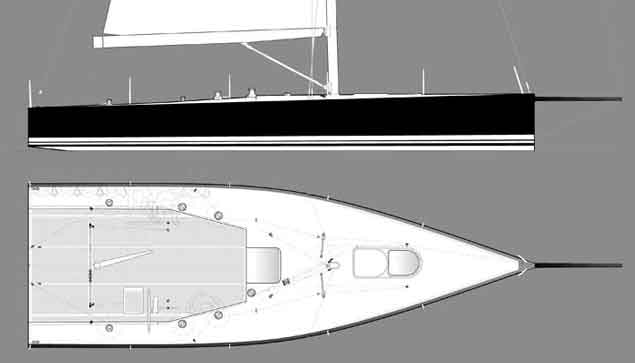 The new design, with the working title of IC-37, is a dedicated raceboat with a flush deck, open cockpit, and square top main reflecting the latest developments from Grand Prix inshore racing.
The new design, with the working title of IC-37, is a dedicated raceboat with a flush deck, open cockpit, and square top main reflecting the latest developments from Grand Prix inshore racing.
Unlike the Swan 42, which was built to cruise and race both around the buoys and offshore, the IC37 is purpose-built for competition. The flush deck, square-top main, open cockpit and wide beam carried all the way to the transom are all hallmarks of a thoroughbred raceboat, designed to be pushed hard on all points of sail.
“It’s definitely a planing downwind design,” says Mills, who founded his eponymous design firm in 1996. “We tried to find a displacement that produces that outcome, but still provides a boat you can build within the determined cost envelope and doesn’t leave you lacking stability going upwind. It will be an exciting boat to sail.”
Since the Rolex New York Yacht Club Invitational Cup is a Corinthian regatta sailed in supplied boats, the design brief also specified that the boat be sturdy, relatively straightforward to sail and welcoming to amateur sailors.
“One of the goals was to accommodate a wide range of ages of both genders,” says Mills. “It would be easy to do a lighter boat that’s very aggressive and very dynamic and required burly 20-somethings to sail it. But that would fail against the requirements of the club. We’re trying to create a boat that’s light and high performance, and can be sailed aggressively by a wide variety of sailors.”
The IC37—a working class title that's subject to change—will measure in at just over 37 feet, or 11.3 meters, with a 6-foot retractable sprit. The beam is just shy of 12 feet and the displacement is scheduled to be approximately 8,000 pounds with 50 percent of that in a T-bulb that will draw just more than eight feet. A two-spreader carbon rig will support 900 square feet of upwind sail area and 2,000 square feet of downwind sail area. The projected ratings for IRC, ORC and ORR are 1.180, 542.7 and 545.3, respectively.
“We were overwhelmed with the response to our initial request for proposals,” says NYYC Sailing Committee Chair Paul M. Zabetakis, who skippered the Club's Invitational Cup entry in 2015. “We feel that’s a strong indication that there’s an opportunity in sailing for the next great one-design class. While our primary goal is to create a boat that will sustain the Rolex New York Yacht Club Invitational Cup well into the future, we also hope that the momentum provided by the Club’s investment will establish a class that will reinvigorate a general interest in Corinthian yachting in larger boats.”
While the class rules are a work in progress, the Club is committed to sustaining the amateur focus of the Invitational Cup and promoting the inclusion of women and youth sailors.
With the design selected, the next step is to choose a builder. Experienced yacht builders from across North American and around the globe have expressed an interest. The Club expects to make that decision within the next few weeks.
“While we have more than two years until the start of the 2019 Rolex New York Yacht Club Invitational Cup, our timeline doesn’t have a lot of margin for error,” says NYYC member Arthur J. Santry, who chaired the IC37 Selection Subcommittee. “We hope to start the tooling by mid July and sea trial the first boat before the end of the year.”
Commodore Lotz' connection to the Rolex New York Yacht Club Invitational Cup goes back to the inaugural competition in 2009, which he won while representing the host club. He also claimed two Swan 42 National Championships.
"Each time we run the Invitational Cup, the bar gets raised," Lotz says. "The teams come to Newport better prepared and the competition gets more intense. With the IC37 we have the perfect boat to continue that trend. We expect the 2017 event, the final one for the Swan 42, to be the most competitive yet. We anticipate the switch to the IC37 will increase both the interest in competing and the effort each invited club puts toward winning Corinthian sailing's top prize."



























